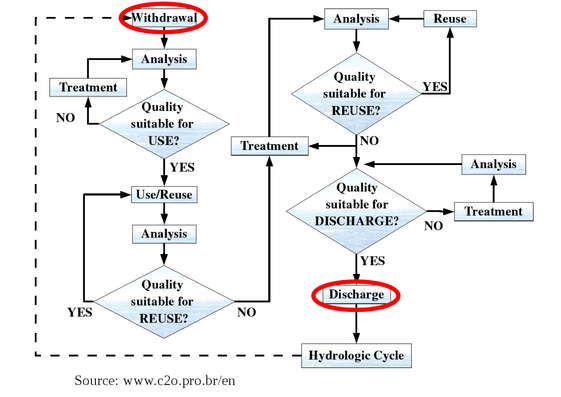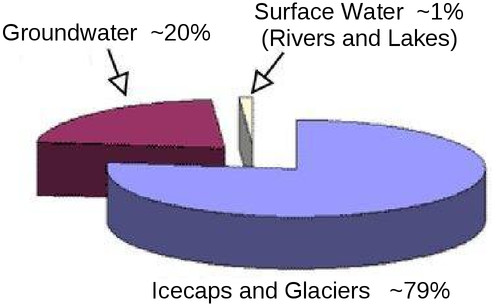7. Water - Where to find?
Let's analyze the interfaces of the cycle of water use/reuse with natural reservoirs, the withdrawal and discharge.
About 97% of available water on earth is salt water (oceans and seas), and only 3% is freshwater.
From the 3% of fresh water only ~1% (or 0.03% of total) is surface water while ~20% (or 0.6% of total) of all fresh water is underground and ~79% is frozen in ice caps or in glaciers.
So there is about 20 times more fresh water underground than on the surface.
 | However it is important to remember that at sedimentary basins the salinity of the water tends to increase with depth. And so, in these cases, there is fresh water only in the upper layers. |
7.1. Hydrologic Cycle
Earth's water flows through different compartments: Atmosphere, Hydrosphere, Geosphere and Biosphere, by different processes (evaporation, precipitation, runoff and infiltration) called Hydrologic Cycle.
The ocean is constantly losing water which evaporates from its surface. However, the volumes of incoming and outgoing water in the oceans are so precisely balanced that they remain constant for short intervals of geologic time, such as years, decades or even centuries.
But on large scales of thousands to millions of years, however, the balance may change. During the ice age (~ 20,000 years ago), for example, significant amount of sea water were converted in glacial ice and the sea level was lowered by more than 100m.
And based on proxy and instrumental data, it is virtually certain that the rate of global mean sea level rise has accelerated during the last two centuries!(Source: www.climatechange2013.org/images/uploads/WGIAR5_WGI-12Doc2b_FinalDraft_Chapter13.pdf)
During the Hydrological Cycle the water can be stored in different "reservoirs" with different residence times.



